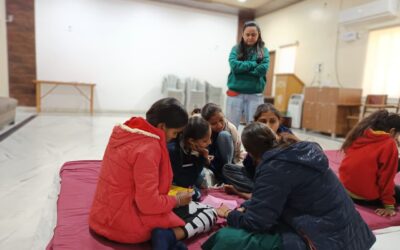My co-fellow, Alston and I started our journey of testing our stereotypes by sharing a samosa on our way to a village called Devali in Udaipur. I believed that families did not prefer sending their kids, especially girls, to urban areas for higher education. As easy as it sounds going around questioning people about their children’s education, it wasn’t. We came across a tea stall first whose owner seemed keen enough to answer our questions. If not for money, he would have loved to send his kids to urban areas for higher education. “That’s a wonderful start”, I thought to myself.
Moving on, as we entered Devali, everyone started staring at us. We were now the suspicious beings invading their space. We came across a watchman sitting outside a multi cuisine restaurant and approached him for questioning. He told us that he wanted his kids to study more and get good jobs, but they forcefully dropped out of school after 10th grade.
Interestingly, the next women I inquired explained to us that most of the girls of the village are educated till 12th grade and then married off, but the boys usually drop out around 10th grade. The next few people we met in Devali at least confirmed the fact that their daughters finished school and then got married immediately after.
Before leaving Devali for another village called Badi, we met a few auto rickshaw drivers who seemed easy to strike a conversation with. They did not want their children to leave Udaipur. They argued that there were enough good institutions around. After waiting for another 15 minutes for a bus towards Badi, an overcrowded one stopped in front of us.
As soon as we got on it, a handful of teenage girls sitting in front started to giggle. I gave them a subtle smile and moved on to have a conversation with the conductor who by now was hanging dangerously from the door. We got off at Badi and made our way towards a general store to ask for a few sips of water. We inquired from a handful of people around Badi, almost all of whom agreed to educate their daughters till 18 and then marry them off. Although there was a part of me that was happy to hear that, it all still seemed somewhat pointless.
Why would they educate their daughters if they only wanted to bind them by marriage and not give the freedom to pursue an empowered life?
We decided to make our way back to Devali. On reaching, we sat next to a corn vendor under what was obviously a banyan tree to pen down all our thoughts. After a while, I struck up a conversation with the lady about her views on marriage and education. She was extremely open to a discussion and pretty liberal about her children’s education. She also introduced us to a rather interesting concept of ‘faisla’ in marriages. She said
“If a couple from the same community marries each other but without the consent of their parents, the groom’s family has to pay a hefty amount to the girl’s family. Although if he or she marries outside the community, they are totally excluded. Even the families meet with them in hiding.”
She explained that this is a major reason why parents don’t want to send their children to urban areas to study, fearing that they would marry someone outside the community. Although my stereotype wasn’t broken, a new angle had suddenly emerged by having this conversation. An ignorant stereotype had been converted into an informed one.




Well written Simant. Paints a visual picture.
Thank you!
Read this today … good one; “As soon as we got on it, a handful of teenage girls sitting in front started to giggle. I gave them a subtle smile …” i think i know which smile :P, but why do you keep distributing it. Also did they giggle and you smile or you smiled so they giggled?
They giggled at us so I smiled :p